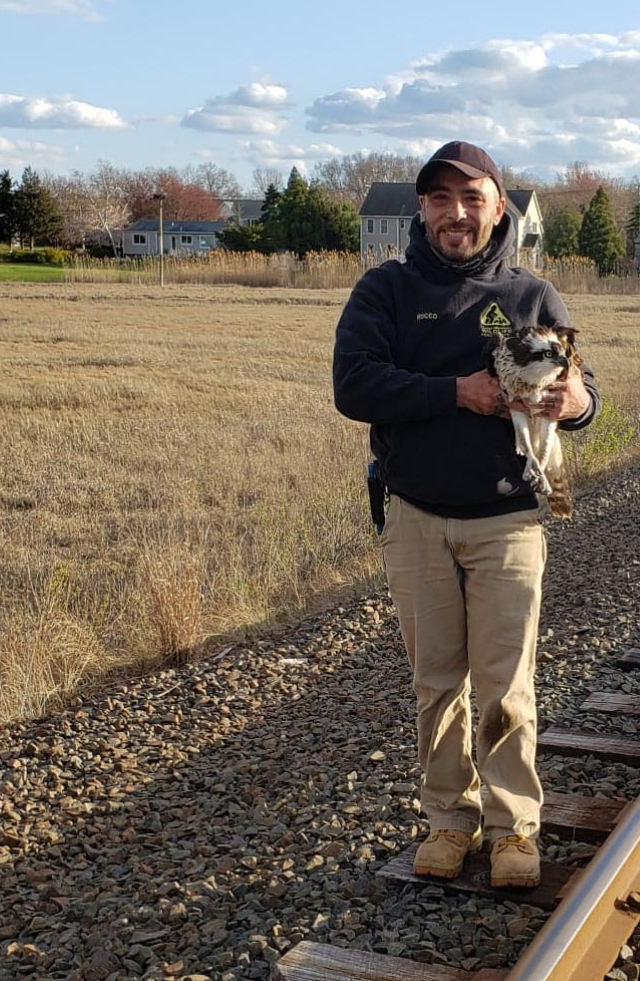Osprey on road to recovery after wind blows it into passing LIRR train in Greenport

On any given day, Joe Rocco finds himself “30 feet in a tree” somewhere on the East End. A rescuer for the Evelyn Alexander Wildlife Rescue Center, Mr. Rocco has completed about 170 rescues since January, he said.
On Thursday, he rescued a gannet out of a Riverhead woman’s flower pot. Then he pulled four baby ducks out of a sewer drain in Center Moriches. The fire department couldn’t get to the ducks, so Mr. Rocco crawled through about 40 feet of drain under the street to reach the ducks and hand them up. Later he responded to a report of an American crow that fell out of a nest.
“It’s craziness,” he said. “I write them all down because I do so many. I keep a log of addresses and phone numbers of callers just so I can touch base with them and let them know how the animals are doing. People appreciate that.”
One recent call stood out: The rescue center received a call from a Long Island Rail Road engineer with a grim report on April 18. On a windy afternoon, an osprey had blown into the path of the train in Greenport. The train clipped the osprey.
Mr. Rocco said the engineer told him he would typically see the ospreys as they hovered above the track, usually at a safe distance from the train.
“He called up and said, ‘Oh my God, I just hit an osprey. It’s at this location by the tracks, by the water, I don’t know if it’s going to be there.’ ”
Mr. Rocco headed toward Greenport not expecting to find an osprey in one piece.
He walked along the tracks in the area west of Pipes Neck Road. The directions from the engineer were spot on, he said. He spotted the osprey hopping around and could see its flight feathers were damaged. Mr. Rocco said it was “incredible” to find the osprey, after getting clipped by a train, was still in good condition besides the 10 damaged flight feathers. He named it Piper.
“He was only able to get maybe like six feet off the ground and then that’s it,” he said. Mr. Rocco was able to corral the osprey — essentially picking it up like a chicken, folding its wings in and holding it by the hips — to be brought back to their Hampton Bays facility.

The osprey, a male, will undergo a procedure called imping to have its damaged feathers replaced with those from a deceased osprey. The procedure will be done at The Raptor Trust, a wild bird rehabilitation center in New Jersey.
Mr. Rocco, who drove the osprey to the facility Saturday, said the new feathers are glued on and the osprey will be back to normal and eventually released near its Greenport nest. He said it’s a fairly rare procedure and he couldn’t find anywhere on Long Island for it to be done.
“You have to pretty much knock the bird out,” he said.
The challenge is finding a deceased osprey that has feathers in good enough condition to be used on the injured osprey. Mr. Rocco said they were able to find an osprey to pull feathers from and The Raptor Trust also has a set.
The procedure was set to be done Sunday and Mr. Rocco said he planned to pick up Piper Tuesday.
The osprey has spent the past couple of weeks in a flight cage. The first stage for any rescued osprey is to be evaluated in the hospital. The second stage is to be placed in a small pen and then when they’re almost recovered, they go into the flight cage, which is about 80 feet by 40 feet.
Ospreys don’t tend to do well in captivity, Mr. Rocco said. One challenge is they may not eat, he said. That hasn’t been a problem for Piper.
“This thing is a gavone,” he said. “You could put fish after fish and this thing eats.”
Mr. Rocco said they weren’t sure at first if Piper was male or female. If it was female, it could have had eggs in its nest, which would have been problematic. Mr. Rocco drove back out to Greenport to further inspect the nest after rescuing Piper and did not find any eggs.
Long Island is a main breeding population for ospreys as they typically prefer to make a home along coastline. The ospreys typically arrive on the North Fork in March and April after migrating thousands of miles from South America.
Mr. Rocco said he called the LIRR engineer back the next day after he found the osprey.
“He was really happy,” Mr. Rocco said.








